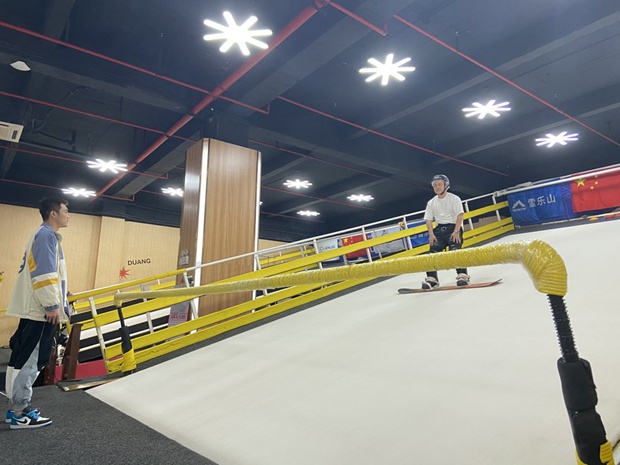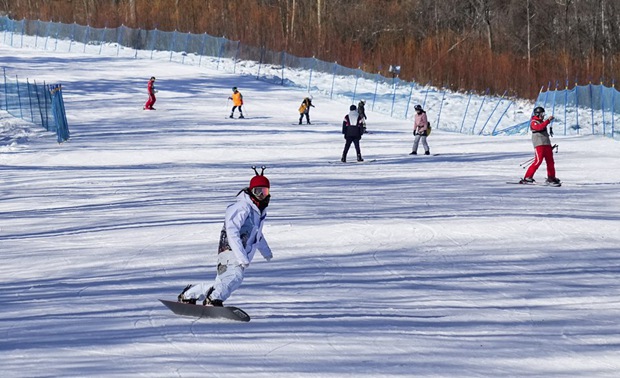Two curling stone-shaped robots extended their arms beneath the surface of the water, each bearing an Olympic torch, as the flame was passed from one to the other.
The scenes played out at a special show held in the icy Yongding River in Beijing ahead of the Beijing 2022 Olympic Winter Games, and this rendezvous between two robotic torchbearers was the first of its kind in Olympic history.
The ongoing 2022 Winter Olympics has showcased not only top sporting prowess but also a futuristic tech extravaganza and an enticing call to winter sports, which pack the potential to drive economic growth.

An amphibious robot is seen during the Beijing 2022 Olympic Torch Relay at the Winter Olympic Park in Beijing, capital of China, Feb. 2, 2022. (Xinhua/Meng Chenguang)
FORWARD-LOOKING TECH
From robots at the torch relay to smart beds and digital currency at the Olympic Village, futuristic technology galore at the Beijing Winter Olympics has swept social media, and some may even find their way into people's everyday lives.
"I'm proud to show the world China's technological advancement in robots," said Tian Qiyan, who led the team in developing the torch-relaying robots in Shenyang Institute of Automation, Chinese Academy of Sciences.
China's robot industry has grown rapidly in recent years, with the sector's revenue exceeding 100 billion yuan (about 15.7 billion U.S. dollars) in 2020 and robot density in manufacturing nearly doubling the global average, according to the Ministry of Industry and Information Technology.
"The robots and relevant technologies developed for the Beijing Winter Olympics will be applied to scientific research and civil uses in the future," Tian said.
In addition to the robots, some technologies designed for improving the performances of athletes in the Games are also expected to enter the wider market.

A learner practices on an indoor artificial ski slope in Haikou, capital of south China's Hainan Province, Jan. 15, 2022. (Xinhua/Chen Ziwei)
Huo Bo, a professor at the School of Astronautics, Beijing Institute of Technology, led a team to develop a smart training management system, which can provide personalized and intelligent training assistance for free ski big air, bobsleigh and several other Winter Olympic events.
"This set of technical equipment and core technology is relatively mature and in the forefront of this field," Huo said.
After serving the Winter Olympics training, the devices will be used in areas such as rehabilitation training, health management and scientific research, Huo added.
BOOST TO WINTER SPORTS, TOURISM
The surging popularity of winter sports brought by the Winter Olympics has also spurred the sports and tourism market, even in places with little snowfall.
Tan Zizhe, a 10-year-old boy living in southwest China's Chongqing Municipality, developed a passion for snowboarding in 2020 under his father's guidance. During this winter vacation, Tan spent almost every day at an indoor skating rink in suburban Chongqing.
Known for its scorching summers, Chongqing has a warm climate all year round and participation in winter sports had been low until the Winter Olympics approached.
Statistics from the Winter Sports Administration Center of Chongqing showed that in 2018, less than 10,000 people participated in winter sports, but the number rocketed to more than 1.5 million in late 2021.
Thanks to the construction of more indoor skating and skiing facilities in recent years, Chongqing residents can participate in winter sports all year round, said Ke Ping, director of the administration center.

Skiers enjoy the sport at Changbaishan Ski Resort in northeast China's Jilin Province, Nov. 15, 2021. (Xinhua/Xu Chang)
In addition to participating in sports, people are also spending more on winter sports shopping and tourism.
Statistics on e-commerce platforms, including Alibaba, showed a big increase from previous years in skiing and skating equipment sales during the Spring Festival holiday.
In Chongqing, snow-and-ice tourism has gained popularity during the holiday, as relevant orders surged more than 30 percent from the same period last year, the local culture and tourism department said.
According to the National Bureau of Statistics, as of October 2021, 346 million Chinese had participated in ice-and-snow sports.
Changbai Mountains, a popular tourist destination in northeast China's Jilin Province, is tapping into the winter tourism fever, marketing hot spring and skating resorts to lure visitors.
"Previously, the scenic spot had more tourists in summer, but with the increase in snow and ice experience activities, it has become a preferred destination even in winter," said Wang Yaxian, a local merchant.














